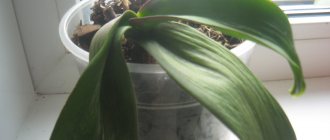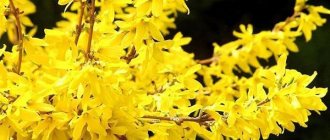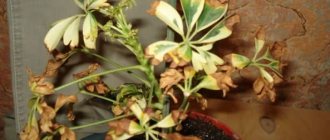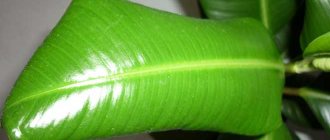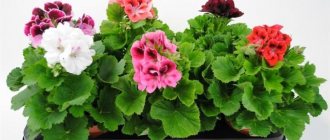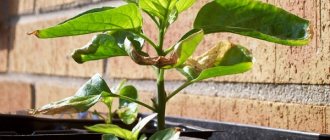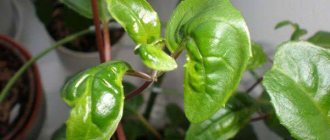The generally recognized “queen of flowers,” the rose, is considered to be a capricious and capricious plant. However, the magnificent beauty responds very gratefully to care and does not require increased attention to her own person. Problems begin only when the plant is not feeling well. If your rose’s castings suddenly begin to curl, do not rush to complain about your pet’s obstinate character. Perhaps the plant is affected by a disease or pests and needs your help.
Powdery mildew
Rose leaves also curl when the plant is infected with powdery mildew. The main symptom of this fungal disease is a dirty white loose coating that thickly covers all above-ground parts of the plant. With severe damage, the curled leaves of roses dry out and fall off, and the “felt” entangled in the shoots prevents new greenery from growing. At the first signs of disease, the rose garden is treated with fungicides, such as:
- Fundazol (10 g/10 l);
- Maxim (10 ml/10 l);
- Fitosporin M (15 g/10 l).
In early spring and autumn, roses are sprayed against powdery mildew with a solution of water (10 l), liquid green soap (300 g), soda ash (50 g), and copper oxychloride (15 g).
How to cure curling rose leaves: tips from gardeners
Phlox diseases and their treatment: why leaves curl
The mosaic virus appears in the plant during budding in the spring. Infected shoots become weak and can no longer be used during propagation; it is better to remove them. Reviewing and adjusting the watering regime will solve the problem of leaf deformation. Shaded areas with roses will help cope with the effects of high temperature on the seedlings.
For your information! Budding is a method of grafting garden plants.
Aphid
This small sucking insect is one of the main enemies of both indoor and garden roses. When aphids are infested, the leaves of the plant become covered with sticky sugary secretions, stick together and curl. By the way, if there are aphids in the garden, then soon their eternal companions will appear - ants, and vice versa, if there is an anthill on the site, then there will be aphids, since for working insects the sweet honeydew secreted by parasites is a favorite delicacy. You can get rid of a small population of aphids using folk remedies:
- daily infusion of celandine (200-300 g of fresh herb per 1 liter of herb);
- citrus infusion (200-300 g of orange or lemon peels per 1 liter of boiling water);
- anti-flea shampoo solution (1 capful of product per 0.5 liters of water);
- kerosene solution (1 tsp per 10 liters of water);
- 7-hour onion infusion (1 medium onion per 1 liter of water).
If aphids on roses have managed to breed, then it is pointless to fight them with folk remedies. Much more effective will be the use of industrial insecticides, such as:
- Agravertine (0.5 ml/0.5 l);
- Actellik (1 ampoule/1 l);
- Vertimek (2.5 ml/5 l);
- Inta-Vir (1 tablet/2 l);
- Karate (0.5 ml/2.5 l);
- Karbofos (15 g/2 l);
- Fitoverm (2 ml/1 l).
Do not forget that ants must be expelled from the garden at the same time as aphids. Against them, it is recommended to install traps with poisoned bait in the area or use special sticky gels. Some experienced gardeners fight ants with improvised means: scald the soil in places where insects accumulate with boiling water, fill anthills with solutions of acetic and citric acid, scatter dry mustard or semolina over the area.
Garden roses have leaves that curl inwards - is this normal or not?
Normally, a healthy rose flower has a leaf blade that is elastic and should not have stains or rust. If the leaves curl, it means something is happening to the bush. There were mistakes made in growing that led to this result. As soon as the first curled leaves appear on the bushes, you need to immediately figure out why this happened and how to solve the problem.
What healthy roses look like
Causes of leaf curling
If twisted leaves appear on a rose bush, it means that the flower is not being cared for correctly. It is necessary to find and eliminate the cause as quickly as possible before the plant dies.
Why do rose leaves curl? This may occur due to lack of moisture and high temperature. When growing roses in the garden, you should keep in mind that the plant, unlike most other crops, loves cool weather. But too low temperatures also negatively affect flower growth. Sudden changes in temperature and cold drafts often cause the leaf plate to curl inward.
Another factor contributing to leaf deformation is improper watering. Flowers should not be watered with ice water. It is also not recommended to irrigate the soil during the day when solar activity is high. Because of this, burns appear on the foliage.
Additional Information! To prevent the soil from drying out, you need to mulch the soil near the rose bushes.
Roses are very demanding when it comes to lighting. Plants cannot easily tolerate prolonged darkening, but they also grow poorly in open sun. It is best to choose a site in the garden so that the bushes are in partial shade. Prolonged exposure to bright sun leads to the appearance of spots, diseases and leaf loss.
Another reason why rose leaves curl is viral diseases. You can immediately notice that a flower is affected by some disease. Leaves may curl outward, wilt and fall off. As a rule, diseases develop very quickly and, if timely measures are not taken, the bush may die. Most often, the crop suffers from powdery mildew, rust and gray mold. The danger of viral diseases is that they are problematic and difficult to cure.
A common reason why rose leaves curl is the appearance of pests. Most often, insects destroy young, succulent leaves.
curled leaves
A deficiency of fertilizers in the soil also negatively affects the growth and development of flower crops. The first sign of a lack of potassium in the soil is the curling of the leaves into a tube.
Spider mite
Another worst enemy of the rose is the spider mite. By piercing the leaf blades, the parasite feeds on the sap of the plant. The active activity of spider mites leads to partial destruction of cells and a decrease in the intensity of photosynthesis. With severe damage, the rose leaves curl, become discolored and dry out, and the entire bush is enveloped in the finest silvery web. In addition, ticks are carriers of dangerous viral and fungal infections.
The main reason for the appearance of the parasite is low ambient humidity, so the best preventive measure against it is spraying the rose garden in hot, dry weather. In the fight against spider mites, products prepared according to the following folk recipes have proven themselves well:
- Finely chopped dry stems and leaves of black henbane (1 kg) are poured with water (10 l) and left for 12 hours, then filtered and 20-40 g of liquid soap are added to the composition.
- Dry (200-400 g) or fresh (500 g) dandelion roots are placed in a 10-liter bucket, filled to the top with warm (about 40 °) water and left under the lid for 2-3 hours, and then filtered. The rose garden is treated with the resulting composition three times per season: during the leaf bloom, during the flowering period and 10-14 days after the second spraying.
- Onion peels (200 g) are poured into 10 liters of warm water and put in a dark place for 4-5 days. The prepared rose infusion is sprayed three times with an interval of 5 days.
- Dry tobacco or shag (400 g) is soaked in warm water (10 l) for a day, then boiled for 2 hours, cooled, filtered and diluted with cold water to a volume of 10 l.
- Garlic (500 g) is crushed in any convenient way (in a meat grinder, in a mortar, or finely chopped with a knife). The pulp is filled with water (3 liters) and put in a warm, dark place for 5 days. Before treating plants, the infusion is diluted with clean water (60 ml/10 l) and 50 g of soap shavings are added to the solution.
If the tick is already in full control of the rose garden, experimenting with folk remedies is useless. They will not be able to cope with a large population of the parasite, and time will be hopelessly lost. In this case, you will have to use chemical acaricides or insectoacaricides:
- Apollo (2 ml/1 l);
- Akarin (2 ml/1 l);
- Aktara (1 ml/1 l);
- Kleschevit (2 ml/1 l);
- Oberon (1 ml/3 l).
Preparations intended for the destruction of ticks also include Aktofit, Bicol, Borneo, Demitan, Dursban, Envidor, Nissoran, Neoron, Talstar, etc.
Many of the mentioned products are compatible with bioregulators of growth (Epin, Zircon, Ecosil). In this way, you can simultaneously solve 2 problems: destroy mites and increase the resistance of plants to adverse environmental factors.
Reviews
Marina, 28 years old:
I recently got roses. Immediately the pot stood on a well-lit windowsill on the south side. But after a few days I noticed that the leaves became limp and then completely curled. As it turned out, this is the result of too high a temperature and dry air. I moved the pot to a cooler room and after a while the flower’s condition was restored.
Svetlana, 32 years old:
Due to high humidity, whitish spots of powdery mildew appeared on my rose. It's good that I noticed it in time. I had to spray the bush with nettle infusion. So that it does not drain, but lingers longer on the leaves, I added liquid soap. To completely eradicate the disease, three treatments were required with a one-week break.
Curling leaves on rose bushes is a signal of errors in care or disease. Therefore it cannot be ignored. In most cases, it is possible to restore the health of the plant by changing the conditions or organizing proper care.
Feeding rules
The need for nutrients directly depends on the variety of the rose being grown. One thing is certain: plants should not suffer from mineral deficiency, otherwise the leaves will change color and curl. Pay attention to the regular application of phosphorus-potassium fertilizers, since these elements are responsible for the resistance of roses to diseases and pests. In addition to complex mineral fertilizers, it is recommended to use chicken droppings, wood ash and slurry to feed roses.
How should you care for a rose so that it does not degenerate into a wild one?
To protect yourself from the appearance of rose hips in the garden instead of a beautiful rose, the gardener needs:
- Feed the plants correctly and regularly. The first feeding is carried out at the end of April (here everything depends on the climate zone). Ammonium nitrate or urea is poured under the bushes, dissolving the fertilizer in water according to the instructions. Each plant should receive at least 1 liter of nutrient mixture. The second feeding is done in June. When setting buds, roses should receive as many nutrients as possible. To do this, they are watered with mullein or chicken droppings dissolved in water. At the final stage of flowering, plants should receive a mixture of nitrogen, potassium and phosphorus. In September, the last fertilizing with potassium magnesium is carried out (20 g per bush is enough);
- water the rose constantly. For irrigation, use settled or rainwater. In summer, up to 20 liters of water are poured under each bush weekly (2 times a week). If the summer is rainy, then the time of watering and the amount of water depend on the rate of drying of the soil. It is better to make a special ditch for watering around the bush;
- carry out preventive treatment against diseases and pests. Use fungicides and insecticides;
- mulch the soil. This helps suppress weed growth and maintain soil moisture balance. During mulching with peat or compost, the roots are fed with nutrients;
- cover the bushes in winter. At the end of October, young roses are covered with spruce branches, old clothes, and leaves. The ground under mature bushes is sprinkled with sawdust. Large shrubs that cannot tolerate cold weather are covered with a frame method, covered with burlap and special fabrics, protecting them from wind and snow.
Removal of everything unnecessary on the bush is carried out annually
Note! Before the first snow falls, old dried shoots, buds, and leaves are removed from roses. The remaining stems are cut by 1/3, then the roots are earthed up, pouring about 15-20 cm of soil on top of what is already there.
Such a plant will not grow into a wild bush next spring; it will bloom and develop better.
Main causes and photos of the problem
Leaf deformation can be caused by several disorders at once. The most common ones include the presence of pests or diseases, but improper care of indoor plants also plays an important role.
Before starting treatment, it is necessary to find out exactly what caused the curling of the leaves, because each of the existing causes requires an individual approach.
Below you will see what a plant with curled leaves looks like:
Pests
The Chinese rose is quite resistant to a variety of pests, but the plant cannot always resist damage from spider mites or aphids. You need to look very carefully at the bottom of the sheets.
- Aphids and mites live in small colonies, so it is impossible not to notice them.
- The spider mite lives up to its name because it entwines damaged areas with a slightly noticeable web. If the curling of hibiscus leaves is caused by these pests, then it is necessary to spray the flower with a soap solution. This procedure should be repeated several times.
- If the leaves quickly curl and fall off, this indicates the presence of scale insects. Scale insects are cleaned with a regular brush or rag soaked in an alcohol solution. The alcohol solution can be replaced with soap.
Read about common diseases of hibiscus leaves here.
Our experts have also prepared articles about the following problems with hibiscus:
- What to do if the roots, stem or tips of leaves dry out and why did the problems arise?
- Why can it shed its unopened buds, how to save it?
- Why do the leaves turn yellow and fall off?
Infectious chlorosis
Often the amount of chlorophyll in Chinese rose leaves decreases, so they begin to curl. A disease such as infectious chlorosis is mainly transmitted by pests. The most common carriers are ticks, aphids and thrips. First of all, it is necessary to get rid of unwanted pests, and then water the plant with a solution of iron chelate and iron sulfate.
Priming
Hibiscus needs soil that is well permeable to air and moisture. Purchased peat-based soils are not entirely suitable for successfully growing such a plant. In this case, the leaves may begin to curl and the plant may die as a result. It is necessary to add leaf humus, which makes the soil moisture-absorbing. Adding sand or turf soil also has a great effect on the soil.
Fertilizers
In order for the Chinese rose to grow and bloom normally, it needs a lot of copper, iron, magnesium and potassium. If the plant's leaves begin to curl, this may indicate a lack of microelements. It is necessary to fertilize the soil with special substances as soon as possible.
Fertilizer for the growth of hibiscus, which is sold in any flower shop, is quite suitable. To ensure that the problem no longer makes itself felt, you need to feed the plant once a month.
Watering
If the flower is constantly located in a room with sufficiently dry air, this will certainly provoke rapid curling of the leaves. It is not recommended to allow low humidity levels in the room. You can place a tray with wet sand near the potter.
As soon as the sun's rays hit it, the moisture will begin to evaporate, which will have a positive effect on the growth of hibiscus. It is worth noting that to increase air humidity, you need to use only filtered water. It is also recommended to spray the leaves of this plant once every few weeks, but only very carefully.
Lighting
The main enemies of the Chinese rose are direct sunlight. The plant loves light very much, but from such rays it can get burns on the leaves, especially if the flower stood in the shade most of the time and then came into the sun.
Many gardeners recommend paying special attention to lighting, because not only the problem of leaf curling, but also the general condition of the plant depends on it. It is necessary to place the hibiscus in a place where there is a lot of light, but not too hot
In this case, you should water the plant as often as possible and ventilate the room.
Temperature
Inadequately keeping hibiscus in a cold room will cause the leaves to curl. Optimal temperatures should not be below 18-21 ºC. Hypothermia causes a draft, so you need to choose the right place where the plant will stand.
Chinese rose leaves curling is of course a serious problem, but it can be dealt with quite easily if you know the true cause of its occurrence. By taking the right treatment measures, you can return the plant to its former beauty and health without any problems. The hibiscus will then delight the owner for a very long time with its lush crown and beautiful flowers.
Treatment and prevention
What to do if the leaves of your home rose turn yellow and fall off:
- To get rid of parasites that deprive plants of their strength and take away nutrients, you need to treat the leaves and stems with fungicides. They will also help cure powdery mildew and black spot. It is preferable to use drugs that have a systemic effect. Before the procedure, you need to get rid of the affected parts of the plant to speed up recovery;
- care must be taken to ensure that the rose is not exposed to the scorching rays of the sun and is protected from the cold wind. Dry air in the room is detrimental to the plant, so you will have to do additional humidification. In summer, it is recommended to spray the leaves daily, especially if the rose remains indoors and does not move to the balcony. You can place glasses or bowls of water on the windowsill so that it gradually evaporates, humidifying the air;
- excess or lack of fertilizer is adjusted depending on the symptoms of the disease and soil characteristics. It must be remembered that any feeding should be stopped when the rose is weakened. This concerns infection with various fungal diseases and the destructive effects of parasites. Once the flower has recovered, you can return to using fertilizers.
Healthy indoor roses will reward you with lush blooms
Flower growers, especially beginners, do not always immediately understand why the leaves of indoor roses turn yellow
They forget that they need to think not only about timely watering and fertilizing, it is important to maintain high humidity and ventilate the room daily. Yellowing and falling leaves occur in a weakened plant, the rules of care for which are not followed.
The rose is capricious, but if you pay enough attention to it and follow all the recommendations, it will delight you with abundant flowering, which usually begins in June and continues until November.
